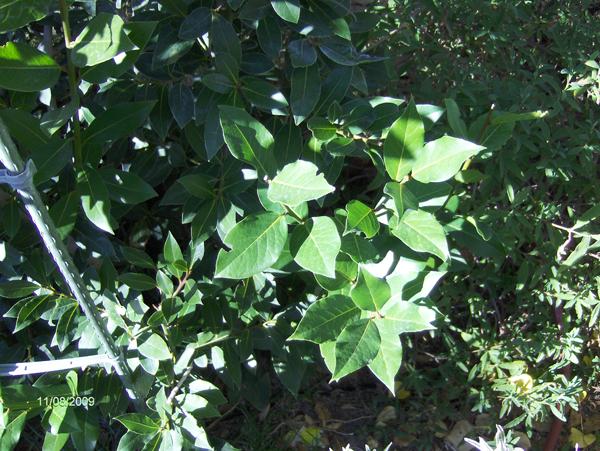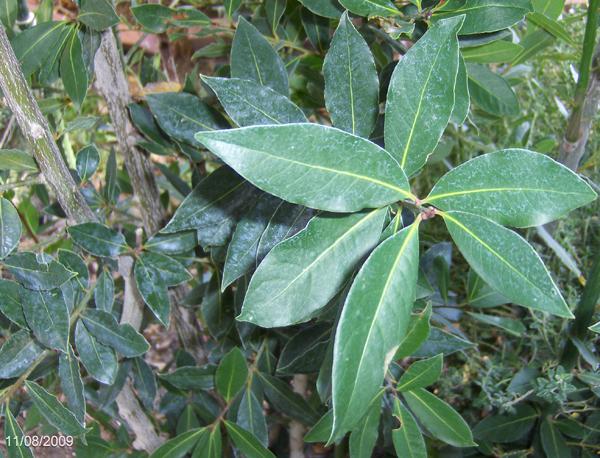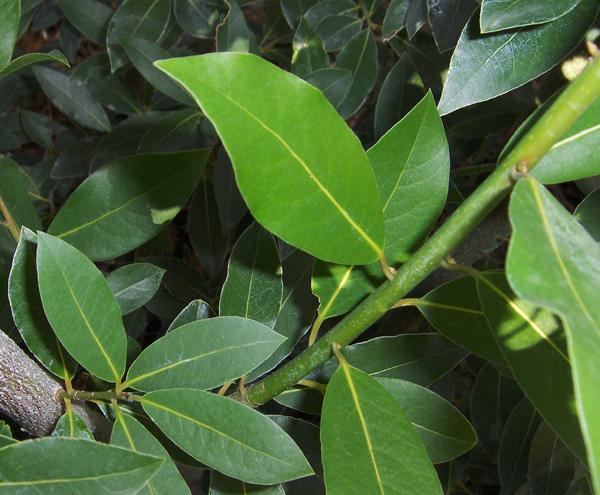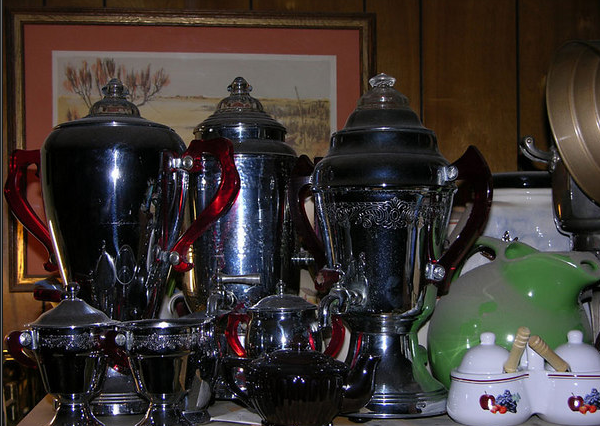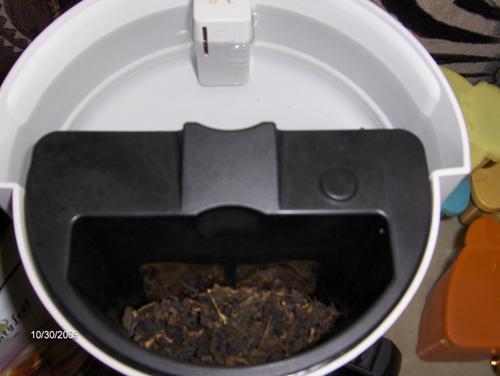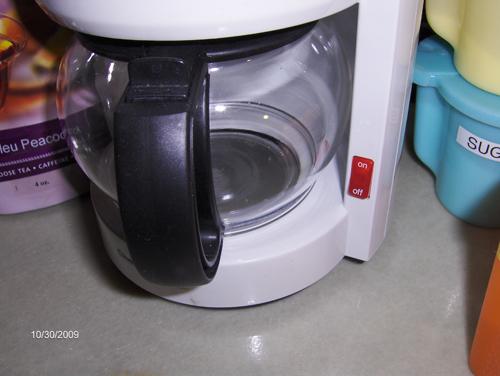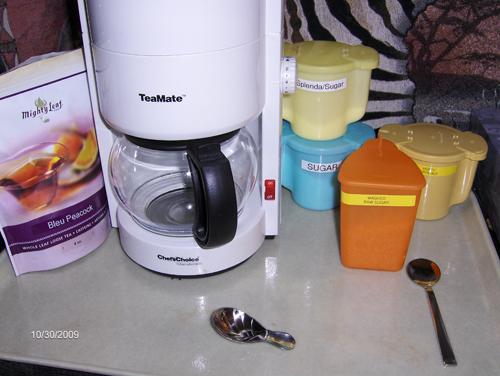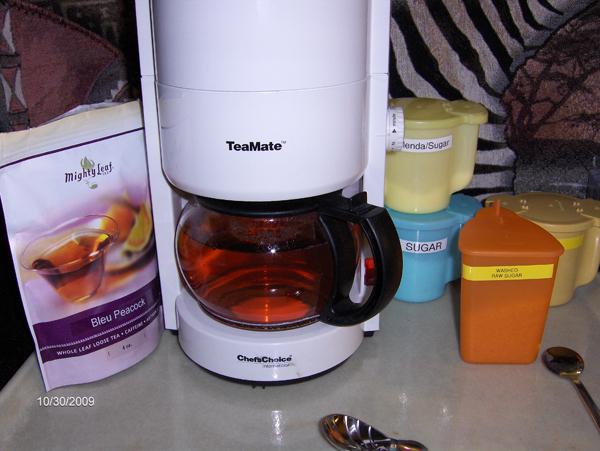-
Posts
11,033 -
Joined
-
Last visited
Content Type
Profiles
Forums
Store
Help Articles
Everything posted by andiesenji
-
I just took some pics of some of my bay trees/bushes. You can see the leaves vary greatly in size and the ones that I think have the most flavor are the darker, year-old leaves. You can see white residue on some of the leaves and those are on the bush that is most exposed to the sun and wind whereas the others are shaded during the hottest part of the day. I think the response of the tree is to exude something onto the surface of the leaves to protect them from the heat and the wind. Those leaves seem to have less aroma. Just brushing against some of the leaves will release a sweet aroma and it remains on my sleeves or gloves, especially when I have been cutting them. I simply pick the leaves and dry them at room temp in a wire colander, tossing them once a day or so, until they are dry and brittle.
-
That's finny - I was wondering how BADLY you were wanting one - cause I knew you'd be wanting one! I was considering ordering one of the Kenwood cooking mixers that is not yet available here, however I wrote to the company and they answered that using the appliance with a voltage converter on regular 110 AC current would not be recommended - not enough power for the machine to operate optimally. No estimate on when it will be marketed here. So, it looks like the Thermomix will be it. My daughter thinks I am nuts but won't say no to inheriting it when I am too decrepit to use it....
-
I checked the Morton & Bassett site and did not see any reference to umbellularia. There are USDA bulletins specifically referencing the source identification of bay leaves, both domestic and imported (especially the Turkish imports). Bulk leaves were seized from several Hispanic markets in California a couple of years ago because the source was not identified and there were insect eggs and larvae and the leaves had not been irradiated. Umbellularia, unlike the true Laurel nobilis is one of the trees especially attractive to Japanese beetles. The leaves often exhibit small black spots which indicate infestation by scale insects (rarely seen on the true bay). Don't use such leaves as there is a mold associated with these insects which is questionable. UC Davis has done several studies on this tree, also at the Stanislaus Co. extension of UC. I studied quite a bit about these and other trees and plants when establishing my herb garden some twenty years ago. There was no internet then, although I was a subscriber to Compuserv and BMUG back in those days and collected a lot of paperwork about the plants in which I was interested. Here's another site that mentions the different varieties of bay leaves: http://www.spice-trade.com/bay-leaf.html And here is a site that offers the wildcrafted California bay: http://worldofgood.ebay.com/California-Bay-Leaves-wildcrafted/350169932749/item Click on "See full description"
-
After reading through the two threads about the Thermomix, I have moved that to the top of my Christmas gift wish list. Actually I can delete the rest of the items because when I get the Thermomix I will have no need of the others. I have a felling that this will be a gift from me to me!
-
Commercially labeled products indicating "Bay Leaves" must be only from Laurel Nobilis. California bay leaves must be labeled as such and wildcrafted leaves must include the certificate number indicating the source area as they are usually collected in state parks or national parks and a permit is necessary. One problem with using California bay leaves for culinary purposes is that some people are extremely sensitive to one or more of the components and can develop migraine headaches even with extremely tiny amounts. My local health food store does sell the certified organic California bay leaves for medicinal purposes but advises that people who are subject to migraine headaches and people who have epilepsy should not be exposed to the leaves. By all means use them if you like the flavor (tastes like eucalyptus to me) but if you are going to serve a dish to other people be sure that they know what they are getting. I would advise against picking leaves from plants with which you are not familiar as there are other plants, with almost identical appearing leaves which are truly toxic. If you live in the eastern part of the country there is Mountain laurel - easy to identify in the spring because it has showy flowers whereas the Laurel nobilis has tiny, yellowish flowers. Mountain laurel is poisonous to many animals as well as to humans. There are other sources for "bay" leaves that are suitable for culinary purposes. I have purchased Indian Bay leaves (Cinnamomum tejpata) when they were sold by Ethnic Grocer a few years ago. The flavor is nothing like bay laurel but has its own attractions. I also tried to purchase some Java or Indonesian bay leaves but was unsuccessful because the package was seized by customs. There is a Canary Island Bay tree (Laurus canariensis) at the Los Angeles Arboretum and its leaves can be used for culinary purposes (one of the arborists gave me a few leaves) but the flavor is much milder and in any event it is now a protected species and it is difficult to obtain specimen plants.
-
Also the California bay has a slightly toxic content and leaves harvested from trees that are near areas that have been threatened by fire may have absorbed chemicals from the run-off from these areas. There have been several bulletins cautioning against using it for culinary purposes. http://www.paleotechnics.com/Articles/Bayarticle.html I live in the high desert and have several laurel nobilis growing in my herb garden. They have acclimated and have not been harmed by temps down to 12° F., although there was some browning of the leaves. The first couple of years they were in tubs and were taken in during the nights when very low temps were predicted but after planting in the ground I used tarps to protect them for the first few years and since then have left then on their own. The leaves are very aromatic when they are fresh. Use much less than you would ordinarily. I stew half a leaf in 2 cups of milk for custards, where with older leaves I would use two. In a bean soup as you describe, it is best to use one leaf and remove it after fifteen minutes, which should be enough.
-
I am pretty sure that boiling the honey did have some effect on the results. I have prepared other recipes in the past that specified boiling the honey (for specific times) prior to using it in the recipe and I believe it is because some water is extracted from the honey during the process, although I have not tested it scientifically. When I attended baking school back in the '50s, we had a class on the history of baking and learned about the various ways flour from various grains was produced from antiquity to the present (or the present as it was 50 years ago). To be truly authentic, the flour would be coarser than whole wheat flour, closer to the texture of fine corn meal, and it would contain a lot of grit from the stones on which it was ground. Not to mention the various things that might be added to flour to add weight or bulk... The total amount of white, very fine flour (similar to what we use today) obtained from a pound of milled wheat might be as little as 1/4 of the total, after multiple "boulting" or "riddling" passes to separate the coarser stuff which was used as porridge, in soups, stews and in coarse cakes that were savory rather than sweet. The slight rise obtained in the barley cakes is only from the beaten eggs. When they describe beating eggs by hand, they mean "with" the hand - using the fingers as a whisk. Messy but possible with a lot of effort.
-
I tried this recipe https://www.wiki.ed.ac.uk/display/potcw/Roman+Honey+Cakes last spring. The amount of flour is significantly greater. I have several reproductions of old cookbooks and one noted that the honey most often used in baking in classical Rome was boiled and skimmed prior to inclusion in most recipes to remove any residual wax or other bits and pieces that may have been in the raw honey. This does change the hydration effect of honey. Even though I used processed honey, I did boil it for a couple of minutes then allowed it to cool prior to mixing it into the beaten eggs. Another honey cake, I think it was made with barley, required cooking the barley meal first to make a sort of porridge prior to adding the remaining ingredients. The batter was baked in molds that produced a design on the cake, probably made from terracotta clay. I have this book: http://www.amazon.com/Taste-Ancient-Ilaria-Gozzini-Giacosa/dp/0226290328/ref=sr_1_1?ie=UTF8&s=books&qid=1257527321&sr=8-1 and also the one by Mark Grant - an earlier edition I bought several years ago. I experimented with several of the recipes that were made with millet, barley, etc. I know there is a recipe for honey cake in the Mark Grant book, not sure about the other and I can't find either one at the moment. (I have a large collection of cookbooks, at the moment not in good order.)
-
-
We had those in my office many years ago - they were supplied by the coffee service that came in once a week to top up the supplies of coffee (Farmer Bros.) powdered creamer (the first one on the market and I can't recall the name) sugar packets, wood stirrers, napkins and other junk. We had a 4-pot commercial Bunn coffee maker and went through several pots a day. I don't know how many of the plastic cup holders we had but there were always three or four "sleeves" of the cone-shaped liners in the cabinet. I remember them mostly from various parties where the cups were used as caps, ear caps, shoulder "pads" (we had a Trekkie who could do some amazing things with office supplies) and one of the doctors with them taped to his chest doing one of the numbers from South Pacific. Brings back great memories. In my kitchen and pantry there is so much stuff inherited from my grandma that I can't begin to enumerate it all, from tiny gadgets to the big electric roaster! And I have several of the large percolators that were used for coffee and other hot beverages. I grew up in a very large, extended family and my grandma needed volume. Certainly there were never any paper cups in my grandma's kitchen. In fact there were only a few mugs, used by some of the men at breakfast, otherwise there were cups with saucers, even in the kitchen. The mugs certainly never appeared in the dining room or even outside for picnics.
-
Did you warm the container prior to filling with the food? I fill the hot food section with hot water and allow it to stand for five minutes or so, empty it and quickly add the food and seal it. As I mentioned in a earlier post, I drove from here to the bay area, stopping twice to eat, and the remaining food was still hot when I got to Livermore.
-
I use the whey from yogurt in savory quick breads and in yeast breads and especially when I am going to bake salt-rising bread. That already has a cheesy flavor (without any cheese) and the whey makes it even more so. Also in breadsticks. I also use it as part of the liquid in corn pancakes. I mix the batter early in the morning and allow it to "work" all day before frying on the griddle for dinner. The batter gets quite bubbly and has a lovely cheesy aroma when stirred. I grew up on a farm where nothing was wasted and my grandma would be spinning in her grave if I poured anything useful down the sink.
-
Here's a photo of the TeaMate box that shows how the innards work. It is a bit more complicated than a coffee maker.
-
The Timer can be set to one minute. This lends itself to repeated brewing as the leaves are not compressed as with a French press type of brewer. One turns off the unit, fills the water chamber, resets the time and flips the switch to ON. This is an older appliance, still available in Europe but discontinued here as apparently it was offered at about the time tea had just began to make inroads into the hot drink market. Occasionally one of these shows up on ebay. Now there are newer brewers being sold. I gave this one to my daughter for Christmas last year and she loves it. http://www.amazon.com/Adagio-Teas-triniTea-Electric-32-Ounce/dp/B0011O1XOQ/ref=sr_1_1?ie=UTF8&s=home-garden&qid=1257009130&sr=8-1 ChefsChoice still repairs these and this one was recently fitted with a new seal that I damaged while cleaning it. I have two.
-
I sent the following recipe to Kerry Beal last March. I got it from a friend who makes it all the time. Sesame Halvah 1 1/2 cups regular sugar 1/2 cup rose water 1 teaspoon cream of tartar 3 tablespoons lemon juice, strained 1 1/2 cups tahini 1 teaspoon pure vanilla extract (If you want other flavors, use what you like – my children love it when I add a few drops of cinnamon oil and orange extract.) Using a candy thermometer, cook the sugar, rosewater and lemon juice in a medium saucepan over medium heat. When the mixture boils and the temp shows 240 degrees, remove from heat. Heat the tahini in a small sauce pan until it is 120 degrees. Slowly add the warm tahini to the sugar syrup and mix with a whisk until combined. Add the vanilla and continued mixing until it begins to thicken. Pour the mixture into a 9 x 13 baking pan, lined with parchment or Release aluminum foil. Cover with a sheet of the aluminum foil or heavy plastic wrap and refrigerate for a day and a half. Turn out onto cutting board and cut into 1-inch squares. There are numerous variations. You can stir pistachio (or other) nuts into the mix while warm. When cool enough to handle, you can roll it into a thick rope and cut into sections and roll in toasted sesame seeds, etc. And you can also dip it in chocolate – I prefer the semi-sweet “buttons” from Guittard.
-
Here's a recipe I "collected" a couple of years ago, specifically for using up the quince pulp left over from making jam. http://www.abc.net.au/tasmania/stories/s1362914.htm I've eaten stews served by an Armenian family that included quince pulp in with the meat. As I recall it was lamb. I have a vague recollection of a Portuguese cake made with quince and I think it was using the pulp. You might try asking David Leite if he knows of a recipe. http://leitesculinaria.com/ If anyone would know, it would be him.
-
Here's the process of brewing the Bleu Peacock this morning. I got out my TeaMate as I want to begin using it again on a regular basis. The set-up in my office. The brewing chamber ready to go. Setting the timer (max time is 15 minutes) Switch set to "ON" At the end of the brewing process the brewed tea automatically decants into the carafe and is held at serving temp (160° F.)
-
I don't see why not. When I have cooked the pulp in my big preserving pan, there is always a "rime" of stuff that is exactly like leather and which peels off easily. I make fruit leathers in my Excalibur dehydrators but have never tried it with quince - I did try it with some fig jam a few weeks ago and it turned out okay. I often have more in a batch than I have jars prepared so just pour the extra on one of the sheets that fit the dehydrator racks rather than put it in the fridge.
-
I've been following this recipe and trying to find a couple of recipes that at one time were my standards for using up the pumpkin seeds after a marathon bout of canning and candying pumpkin (like the Mexican candy). So far no luck but I did come across this: http://easteuropeanfood.about.com/b/2008/11/07/yer-outta-here-john-mccain-gets-a-pumpkin.htm and thought it sounded like something I would like. One of the old recipes I always prepared when my kids were still at home included ground roasted pumpkin seeds mixed into the pumpkin pulp, which thickens it nicely, adds flavor and gives a lovely texture when made into empanadas. I am pretty sure I got that recipe from one of my Mexican neighbors and it had to have been thirty years ago. I used the same filling, although with less sweetening and with different herbs, to make ravioli and my kids loved this dish that was served with a white cheese sauce (no tomato). I am also an advocate of not cleaning the seeds all that carefully. As noted above the stuff becomes very brittle with roasting.
-
I just brewed a pot of the Bleu Peacock blend from Mighty Leaf. This blend includes oolong tea, lavender flowers, jasmine flowers, natural citrus flavor. It produces a very pleasant cup, the flower and citrus flavors do not overpower the oolong and it has a long, smooth finish, a delightful aftertaste that lingers. I do not usually add milk to oolongs but did add just a bit to the third cup and it had little effect on the overall flavor but added a silky texture to the mouthfeel. I liked it also.
-
Several additional ideas may be found here: http://bbq.about.com/rsrch.htm?zIsPG=gSrch&zIsT=Barbecues%20&%20Grilling&zIsD=bbq&terms=Quince In the topic mentioned by mkayahara I posted about my experience with making a batch of quince jam that turned out way too sweet - and my solution. The results turned out so well that I have since prepared the "smoked" version and people (especially my daughter and her family) love it. I am planning on preparing a batch for canning to include in my holiday gift baskets. I have also used the same process with fig jam and that too has been a hit. I canned 21 half-pints of smoky fig jam - made with brown turkey figs - last month.
-

Repurposing Food & Kitchen Stuff You Usually Throw Away
andiesenji replied to a topic in Kitchen Consumer
I just remembered one that I use when cooking a lot of steaks on the grill. As soon as they come off the grill onto a platter I stab one of the disposable white plastic forks that come with take-out food into the steak. I have previously written on the handles either "B-rare" "rare" "medium" or "well" and this saves people having to cut into the steaks to check. I do the same thing with different seasoned meats, chicken and etc., when it isn't obvious how they are seasoned. (Some people do not like garlic or other flavors.) This is particularly important when I am simply filling platters and not taking the food to the tables. -

Repurposing Food & Kitchen Stuff You Usually Throw Away
andiesenji replied to a topic in Kitchen Consumer
You might be surprised at the things you can find in a beauty supply store that can be handy in the kitchen. I checked and the price has gone up since I bought the box I have in the pantry but they are still affordable: http://cgi.ebay.com/Spa-Salon-Disposable-clear-shower-hair-cap-100-PCS_W0QQitemZ250519663617QQcmdZViewItemQQptZLH_DefaultDomain_0?hash=item3a5422b401 I have a selection of emery boards from coarse to superfine to smooth out nicks in knife handles, chopsticks, the edge of a cutting board and most important to "sharpen" the edge of a non-metal spatula (all tasks performed in the past couple of days) and the polishing buffers will remove the tiny rust spots that show up from time to time on stainless steel things. -
It will if you leave the container open to the air for more than a brief period but it still takes a while. I have maintained four distinctly different starters from sourdo international for quite some time but I take care to keep them completely separate - that is, I allow some time to elapse between using the different ones and I keep the "mother" cultures as isolated from each other as possible. I use Cambro containers which seal tightly for the larger batches that I use often and use glass quart canning jars for the smaller batches.


